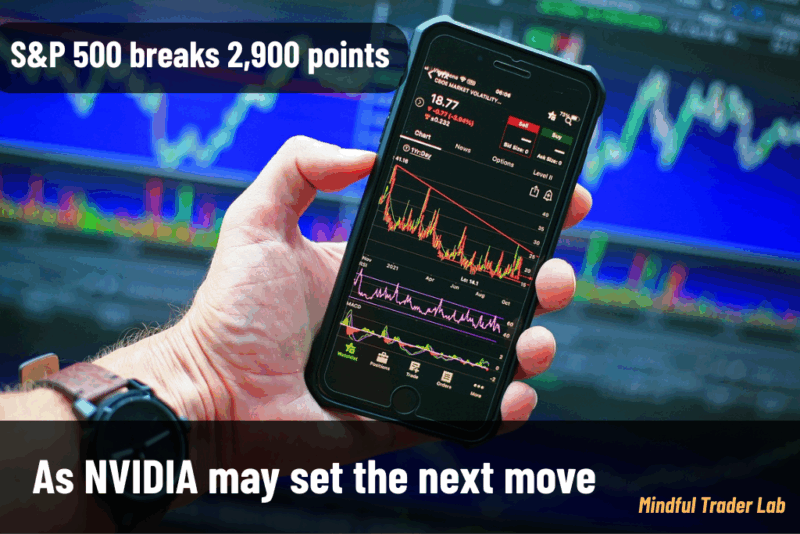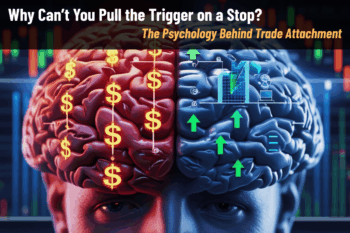Market on the Rise: S&P 500 Breaks 2,900 as NVIDIA Could Set the Next Move

What Today’s Market Psychology Reveals About Investor Behavior
And How to Navigate the “Good News is Good News” Landscape
Have you ever felt like the market has a personality of its own? One day it’s jittery, the next it’s bursting with confidence. Right now, we’re in one of those exhilarating phases where optimism is the name of the game. This week, the S&P 500 smashed through the 2,900-point mark—a level that’s not just a technical milestone but a window into the collective mood of investors worldwide.
We’re in a fascinating moment where “good news is good news, and bad news? Well, it’s barely a blip.” It’s almost like the market is that friend who’s just fallen in love—everything looks rosy, and nothing can dampen the vibe. This “honeymoon phase” is powered by a trio of forces: resilient economic data, strong corporate earnings, and a sigh of relief as trade tensions ease. Together, they’re fueling a cycle of positivity that keeps pushing prices higher. But as traders, we need to ask: How do we ride this wave without losing our footing? Let’s break it down and see what’s really happening beneath the surface.
The S&P 500’s Breakout: More Than Just a Number
When the S&P 500 broke 2,900, it wasn’t just a line on a chart—it was a psychological breakthrough. Think of it like a runner crossing the finish line after a grueling race. That moment sparks something called confirmation bias in investors’ minds: “See? I was right to be bullish!” Suddenly, the optimism snowballs, and more buyers jump in.
This rally rests on three sturdy pillars:
- Resilient macroeconomic data: Numbers like steady GDP growth or low unemployment act like a safety net, calming jittery nerves.
- Strong corporate earnings: Companies beating expectations keep the growth story alive and kicking.
- Easing trade tensions: With fewer headlines about tariffs (check out this Yahoo Finance update on US-China talks), uncertainty fades, and confidence grows.
In psychology terms, this creates a “resource state”—a mental space where investors feel secure and ready to act. It’s a virtuous cycle: confidence drives buying, buying pushes prices up, and higher prices breed more confidence. But here’s the trader’s challenge: Don’t let the party atmosphere blind you to the risks. Staying mindful is key, and you can learn more about that in our Trader Psychology resources.
What’s Coming This Week: Events to Watch
The market’s in a good mood, but what’s next? This week, keep an eye on two biggies: the Flash PMI indices (early signals of economic health) and consumer sector earnings. These could either keep the party going or throw a curveball.
What’s really interesting, though, is how the market’s filtering reality right now. It’s in a “good news only” mode—bad data gets shrugged off like a minor inconvenience. This selective lens can mess with your trading decisions by:
- Tempting you to over-leverage: “Everything’s fine, right? Why not go big?”
- Dulling your risk radar: You might miss red flags when you’re caught up in the hype.
- Blinding you to technical signals: If it doesn’t fit the happy narrative, it’s easy to ignore.
Picture yourself at a loud concert—everyone’s cheering, but you still need to hear the fire alarm if it goes off. That’s your job as a trader this week: enjoy the rhythm, but stay alert.
The Hidden Engines of This Rally
This market surge isn’t just about the headlines. Underneath, there’s a mix of technical factors and positioning shifts at play—like the gears in a machine you don’t see but feel.
For one, hardly anyone’s betting against this rally. Shorting the market now feels like leaving a great movie before the climax—who wants to miss out? Plus, whispers of progress in trade talks (like those US-China negotiations) are stoking what I call “institutional FOMO.” Even the big players don’t want to be left behind.
So how do you play this? I suggest “rooted enthusiasm”—join the upside, but keep your wits about you. It’s like dancing at a wedding but knowing where the exits are. Balance is everything.
NVIDIA: The Market’s Mood Ring
If the S&P 500 is the market’s backbone, NVIDIA is its heartbeat. Its upcoming earnings are the talk of the town, with the potential to steer tech stocks—and maybe the whole market—into the next phase. Since hitting a low on April 8, 2025, NVIDIA’s stock has soared 19.6%, riding the wave of big tech excitement.
As of May 20, 2025, NVIDIA’s trading at $134.387, a dip from its year-high of $195.95. Today’s range shows the push-and-pull: a low of $132.676 and a high of $135.629. That volatility reflects the market’s mixed emotions—hopeful yet on edge.
The buzz isn’t just about earnings, though. The M&A market is heating up, and that’s a classic bull market booster. Why? It:
- Signals corporate confidence: Companies buying others means they’re betting on growth.
- Boosts valuations: “Smart money” moves validate high prices.
- Feeds the narrative: Synergies promise even bigger gains.
NVIDIA’s moment could either turbocharge this rally or hit the brakes. Either way, don’t get too attached—your mindset for trading will keep you steady.
Risk vs. Reward: Walking the Tightrope
The S&P 500’s risk-reward setup is sitting at “neutral” right now—a tricky spot that tests your trading psychology. It’s like hiking a narrow ridge: breathtaking views, but a slip could sting.
What could tilt things? Watch for:
- Economic cracks: Weak data could sour the mood.
- Over-the-top optimism: Too many bulls might signal a top.
If those hit together, you’d get “cognitive dissonance”—when the market’s rosy glasses clash with grim reality. My advice? Practice “vigilant detachment.” Ride the wave, but don’t stop scanning the horizon.
Real-time check: On May 20, 2025, SPY closed at $592.85, off its daily high of $595.336 and above its low of $589.724. That wiggle room shows the market’s still testing its legs.
Brace for a Dip? How to Stay Cool
A small pullback’s looking more likely—maybe triggered by a NVIDIA miss, given its spotlight status. A major crash? Not yet. To keep your head in the game:
- Run mental drills: Picture a 5% drop and plan your moves.
- Set your lines: Know your exits before the chaos hits.
- Zoom out: Corrections clean house—they’re not disasters.
A dip isn’t the enemy; panic is. Prep now, and you’ll turn uncertainty into opportunity.
Wrapping Up: Optimism Meets Awareness
So, what’s the takeaway? The S&P 500 above 2,900, NVIDIA’s big moment, and this “good news” filter paint a vivid picture of market psychology at work. It’s a mirror of human nature—greed, hope, and all.
To thrive here, try “rooted enthusiasm”:
- Plan your exits upfront: Clarity beats regret.
- Stay open to shifts: A pullback’s not a failure—it’s a reset.
- Check your bias: Are you seeing what’s real or what you want?
Trading’s not about nailing every call—no one can. It’s about mastering uncertainty and yourself. Every peak and dip is a lesson in both markets and personal growth. Feeling the pressure? Our Trader Psychology tips can help you stay grounded. Keep learning, keep growing—you’ve got this! 🌟




Be the first to comment!